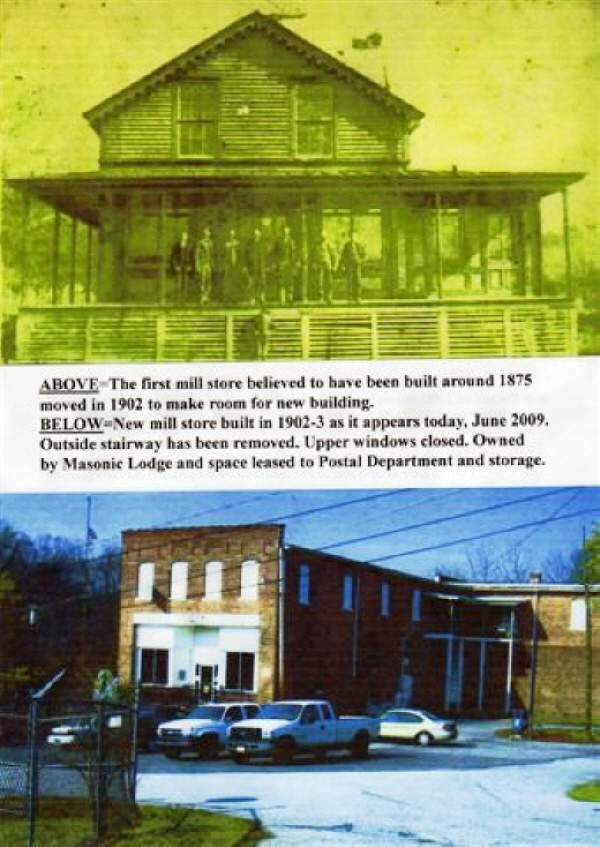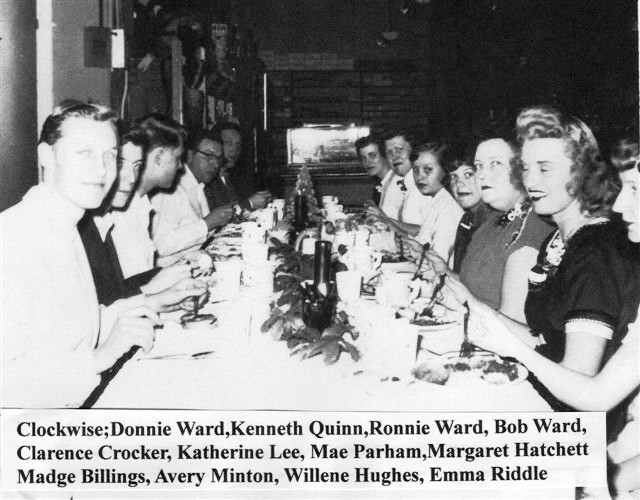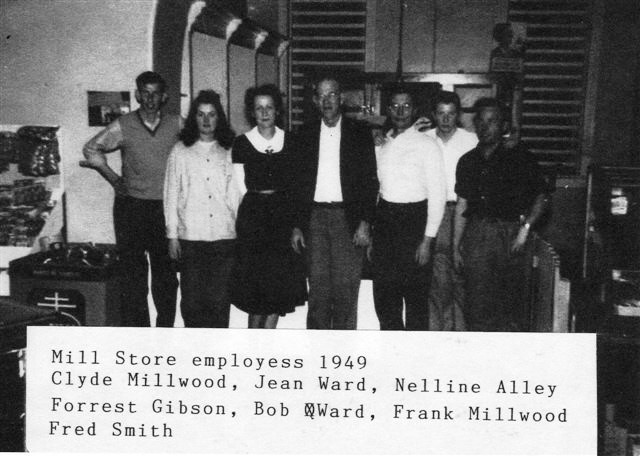The following story about the
Mill Store was furnished by Mr. Clarence Crocker,
a life long Glendale resident and manager
of the store for several years.

I have no record of the exact
date when the first mill store was constructed and put
into operation. All indications are that it was
built somewhere about 1875 or before.*
When I joined Glendale Mills in 1948 as Mill Personnel
Consultant and Manager of the Mill store and it
concessions, I found a picture of the original store
along with D.E. Converse company coins and coupons
used as cash for purchases by employees along with
some papers which gave some details about the old as
well as the new store. It was a large two story
wood structure. It not only contained the General
Merchandise store but also had space for the Mill
Office, Post-Office, and a Doctor’s office. The
building stood on the location where the present
building stands and was moved in 1902 to the
place where a metal warehouse stands today, making
room for the new store. When the old store was
torn down in the thirties, Mr. Charlie Sams,
Postmaster, bought the building to build some houses
on his place at Cedar Crossing about one mile above
Glendale on the Glendale-Clifton road.
* (Footnote; While reading an article in my
historical files on Dexter Converse since writing the
Glendale Mill Story article, I found a one line
reference to Albert Twichell which fixes the date of
the store construction much earlier than suggested in
this article. It states;
“Mr. A.H. Twichell, brother-in-law to Mr. Converse,
came to the mill in 1859 as bookkeeper and clerk in
the company store”.
This means that the store was constructed during or
before 1859.
Clarence Crocker; August 20, 2009)
The new store, built in a L shape, was made of
brick and had two floors. The first floor was
used entirely for store purposes. The second story was
divided into two sections. The front part was used by
the store to display merchandise while the right wing
had a section for Masons, Woodman and Redman meetings
along with a room for the Magistrate. I found quite a
few copies of warrants when we cleaned out that
section in 1948-49 as well as Woodman paraphernalia. A
stairway on the inside led up to the store merchandise
section while stairs on the outside of the building
led up to the right wing.
One of my fondest memories of
the company store goes back to the early thirties
when I was just a young boy. Dad got a
dinner break from the mill and we would sometimes
carry him lunch. We met on the outside stairway on the
store. Sometimes dad would go into the store and buy a
package of saltines and a can of sardines. Got both
for about a nickel. Sometimes he would buy some candy
or some other goodie. Boy that was living high on the
hog. That was like a Sunday School picnic to me. At
that time Mr. Haskel Turner, who had replaced Mr. C.A.
Sams when he became Postmaster, was bookkeeper. Mr.
Banks Thomas, Mr. Spot Hopper and Mr. Andrew Thomas
were clerks. Henry Patton, a black man worked part
time as janitor. (Many years later, Henry Patton was
the janitor at the last Glendale Elementary School. He
was known affectionately by all as "Uncle Henry".)
The Mill store has always carried a complete line
of groceries. Barrel molasses, hoop cheese, loose
coffee, salt mackerel and plug tobacco were
favorites. A moderate line of hardware, clothing,
shoes and drugs were maintained. Twice a year,
representatives from fine clothiers came
to take orders for tailor made suits and coats
for both men and women which could be bought on time
through the store. Wood and coal were also sold
by the store as well as a limited line of animal feed.
Cut cord wood was brought to the store by farmers in
exchange for groceries or other needs. Someone said
that the store could meet the needs of one from the
cradle to the grave. They did indeed handle baby
clothes and a family could have a casket made through
the store or could buy supplies to make one
themselves. I disposed of perhaps a hundred or so
casket handles, hinges and brass corner knobs used to
decorate the caskets. Many families buried their own
dead up into the 1920-30s.
Being older than some of its
suppliers, Glendale Mill Store had contracts with all
major tobacco companies and bought cigarettes, snuff
and chewing tobacco directly from the manufacturers.
Chewing tobacco was bought in bulk layers packed in
square (10X10) wooden boxes. The clerk could cut
a nickel, dime or larger plug as the customer wished.
It also had contracts with clothiers such as Hanes
Underwear and Dickie Work Clothes and others which
were binding until the day they closed their doors.
While many believed Mill stores overcharged, they
did have to charge extra to cover their loss through
credit and pilferage. Ninety percent of the mill store
business was on credit and pilferage was always higher
in mill stores. For example, I had just returned to my
office from a tour through the mill and was combing my
hair. Looking into the mirror I saw a person slip a
man’s hat under their top coat. On another occasion, I
was looking into the mirror on the door of the meat
case when I saw a person slip a bag of coffee up their
coat sleeve. Both were well known persons in the
community and it would have been hard to believe they
were pilfering had you not witnessed the act. Of
course, I faced both and they admitted what they had
done but no charges were filed against them. We never
charged anyone caught pilfering.
One fact, which not many knew, was that Mill store
profits were limited by labor laws and were checked
annually by the State Labor department. They could be
fined for overcharge and excess profits disbursed to
employees if so judged. This did not apply to
personal/public owned stores.
During the prime time of Mill
stores, there were few to no quick title cash or pay
day loan places for persons needing money for
emergencies. The mill store did not loan money but
when a person needed cash they would often come into
the store, charge a pair of shoes, a hat, overalls or
cartons of cigarettes to sell to someone at a
bargain, for cash.
Mr. Carl Bates, who had
replaced Mr. Turner on his retirement, had retired and
Nellene Alley was serving as bookkeeper and Mr. Pettit was still
General Manager when I joined the company. We
discontinued Mr. Pettit’s service and I hired a new
bookkeeper, Howard Lee, with Nellene returning to a
clerk’s position. As the Company was renovating
the Mill and Village, we also renovated the Mill
Store. We painted the interior, installed florescent
lights, replaced the old pot belly stove with steam
heat. Though we never got air conditioning, we used
the fans on the heaters to cool in the summer.
Removing counters, widening aisles, installing a glass
display meat counter, we converted the store to self
service, with clerks available to assist the customers
in their purchases and charges. We added a paint
department, auto tires, batteries, gas and oil
and added new rest rooms. In the fall we put in a
large line of toys and Christmas goods which could be
purchased on a lay-away program.We also carried a
small line of furniture such as chairs, dinette sets,
etc. We could and would order most anything a customer
requested within reason.
Our motto was to serve the
customer and would you believe, I preformed a wedding
in my office one day. Knowing that I was a Notary, a
couple approached me and asked that I marry them. I
did, and they went out of my office holding hands as a
happily married couple to face a world they had never
experienced before.
Though the store had for many
years made delivery to the homes by horse and wagon,
they had an old badly worn truck in 1948 so we
purchased a new pick-up truck. We began a lunch room
serving hot and cold sandwiches, etc. at the mill and
also a short order cafe in the new gymnasium. The
second story was discontinued for store use and was
renovated for the Mason Lodge. A Doctor/nurse office
was added in the front of the store building once the
small office located on Mill street in front of the
mill was relocated and converted into a
dwelling.
Among our many employees were, Howard and
Katherine Lee, Nellene Alley, Bob, Jean, Richard,
Donnie and Ronnie Ward. Clyde, Frank and Bud Millwood.
Bob and Mary Jo Sams, Forrest Gibson, Johnny Corn,
Willene Hughes, Avery Minton, Fred Smith, Dorothy
Hyder, Gladys Linburg, Kenneth Quinn, Clair Dillard,
Mae Parham, Lucile Cash, Margaret Hatchett, Flora
Collins and Madge Billings.


The store closed in 1958 and
the building was sold to the Glendale Masonic
Lodge. The Second story is used for Lodge and Eastern
Star purposes while the first story is occupied by the
Post-Office and storage rental space. The outside
stairway has been removed with an entrance being added
at the back of the building and the inside stairways
are used to reach the second floor.





